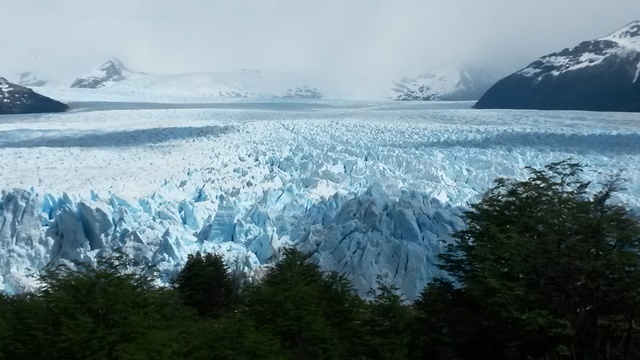Patagonia
We flew from Buenos Aires – the city that never sleeps – to El Calafate, Patagonia: A three-hour flight and a world apart. The bare, shrub-covered hills of El Calafate are scattered with boxy square houses. The sky is a brilliant blue and glacial winds blow most of the time. It’s quiet and almost deserted. Just a fifteen-minute walk from our little hotel on the scrubby hillside, we came upon a charming village nestled in a sheltered valley, where pine and shady poplar trees line the streets; restaurants are plentiful; and there are more bakeries and chocolate shops than in the entire Westside of Los Angeles. Living in the cold climate must call for a heavy dose of comfort food.
We awoke the next morning to a picture perfect day with sunny skies and no wind. We couldn’t have asked for finer weather conditions for our visit to Perito Moreno Glacier- a two hour drive from El Calafate which takes one through exquisite scenery, past flamingos on the shores of Lago Argentina, and across terrain where black-chested buzzard-eagles fly, and giant condors soar on the wind’s current. It’s impressive to see how Argentinians care for this national treasure. It’s pristine. Zero litter: Not a soda bottle top, a scrap of paper, nor a cigarette stub to be seen, and visitors are not allowed to remove anything. Not a stone, a flower, a stick, nor a leaf. Nada!

Perito Moreno Glacier covers 250 square kilometers, an area as large as the city of Buenos Aires. A catamaran transports visitors to within 250 meters of the glacier’s white spires and jagged peaks which loom above the boat, making one feel insignificant in size. Up close, the glacier resembles a humongous crunchy snow-white meringue gateau. Between the soaring shards are sheets of opaque blue ice, like sheets of blue crystal. Every now and again one hears a boom that carries across the silence, followed by the crackling sound of breaking glass as pieces of the glacier break off and tumble into the lake.
The highlight of our stay in Patagonia were the three days that we spent at Estancia Cristina. The Estancia (farm) was established in 1914 by a British couple – true pioneers – who found this remote and inaccessible corner of Patagonia where they chose to build their home and small farm. Like Noah and his ark – in their rudimentary wooden boat – they brought cows, sheep, horses and goats from the mainland a few at a time, crossing the choppy waters of the lake and maneuvering between icebergs.

We set out from El Calafate in a glass-enclosed boat for the three-hour ride to the Estancia. Lago Argentina has a soft milky turquoise tone, caused by the sediment from the glacier water which locals call ‘glacier milk’. We drifted past massive icebergs – spectacular sculptures created by nature’s master sculptors: The glaciers, the water, the sun, and the wind.
The Estancia has three cottages – each cottage has four suites and the maximum number of guests on any night is fourteen. Everything is included in the price of an overnight stay: All food, soft drinks, tours, and horse riding. Food is prepared by a highly acclaimed gourmet chef who serves up superb dishes from his ā la carte menu. There is a comprehensive list of treks and horse rides, all of which are led by the Estancia’s guides. Maps are provided for the less challenging trails which visitors can do on their own. The staff are all young, super professional, caring and upbeat, and show a great sense of attachment to, and pride in, the Estancia.
For Stan and me, our daily horse rides and the trek to the Upsala Glacier were an indescribable high. We rode on healthy, frisky, well cared for horses with our gaucho in the lead. We waded through rivers; rode up into the mountains along corridors of stone carpeted in tiny wild flowers; passed lakes where pure white swans with long black necks and red beaks, glided gracefully across the water; and came upon waterfalls that sent crystal clear pure glacier water cascading down the mountainsides.


On the day we visited Upsala, the winds were blowing with ferocious force. We sealed ourselves against their icy bite with layers of clothing and followed our guide along a path where the stones gleam like burnished wood from the constant winds and the lakes sparkle like sapphire gems. The view from the highest observation point where three glaciers meet was breathtaking. Upsala which covers 50 kilometers in length and 10 kilometers in width is the largest of the three.


Back at the Estancia while warming ourselves by the fire – steaming cappuccinos in hand – we were given the ‘bad’ news by the young manager Pedro. The winds were too strong for boats to cross Lake Argentina so no boats would be arriving or departing that evening. We would have to spend another night and a full day, on the house as guests of the Estancia.
Never in our lives have we been the recipients of such exquisite ‘bad’ news!
